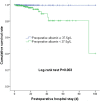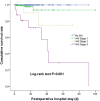Preoperative hypoalbuminemia was associated with acute kidney injury in high-risk patients following non-cardiac surgery: a retrospective cohort study
- PMID: 31477030
- PMCID: PMC6719349
- DOI: 10.1186/s12871-019-0842-3
Preoperative hypoalbuminemia was associated with acute kidney injury in high-risk patients following non-cardiac surgery: a retrospective cohort study
Abstract
Background: Acute kidney injury (AKI) is a common complication following non-cardiac surgery with adverse short- and long- term morbidity and mortality. Evidence shows that hypoalbuminemia is associated with increased AKI risk in patients with infectious diseases and cancer and following cardiac surgery and transplant surgery. However, little evidence is available on non-cardiac surgery population. Thus, we investigated the association between preoperative hypoalbuminemia and AKI following non-cardiac surgery.
Methods: We retrospectively assessed perioperative risk factors and preoperative serum albumin concentration in 729 consecutive adult patients who underwent non-cardiac surgery from July 1, 2017, to June 30, 2018. Each patient was categorized according to maximal Kidney Disease Improving Global Outcomes criteria based on creatinine changes and urine output within the first week after surgery. Multivariate Logistic regression models were used to analyze the association between preoperative hypoalbuminemia and postoperative AKI.
Results: Of 729 patients, 188 (25.8%) developed AKI. AKI incidence was higher in patients with preoperative serum albumin < 37.5 g/L than in those with preoperative serum albumin ≥37.5 g/L [35.9% (98/273) vs. 19.7% (90/456), P < 0.001]. Multivariate logistic regression analysis showed that preoperative serum albumin < 37.5 g/L (odds ratio 1.892; 95% confidence interval 1.238-2.891; P = 0.003) was independently associated with postoperative AKI. Patients with preoperative serum albumin < 37.5 g/L tended to have a higher but not significant ratio in AKI stage 2 (2.6% vs 1.1%, P = 0.144) and much higher ratio in AKI stage 3 (4.8% vs 0.7%, P < 0.001) than those with preoperative serum albumin ≥37.5 g/L. AKI patients had a higher in-hospital mortality rate [6.9% (13/188) vs. 0.2% (1/541), P < 0.001]. Kaplan-Meier analysis revealed that the cumulative survival rate decreased with increasing AKI severity (P < 0.001). Postoperative AKI was also associated with other worse outcomes, such as prolonged mechanical ventilation [53.4 (33.0, 73.8) vs 14.7 (11.1, 18.3) hours, P < 0.001], intensive care unit stay [4.0 (3.1, 4.9) vs 2.0 (1.8, 2.3) days, P < 0.001], postoperative hospital stay [17.8 (14.8, 20.9) vs 12.3 (11.3, 13.3) days, P < 0.001], and higher total cost [13,453 (8538, 20,228) vs 11,306 (6277, 16,400) dollars, P < 0.001].
Conclusions: Preoperative hypoalbuminemia was independently associated with AKI after non-cardiac surgery, and postoperative AKI was associated with poor outcomes.
Keywords: Acute kidney injury; Hypoalbuminemia; Non-cardiac surgery; Prognosis.
Conflict of interest statement
The authors declare that they have no competing interests.
Figures
References
MeSH terms
Substances
LinkOut - more resources
Full Text Sources
Medical




